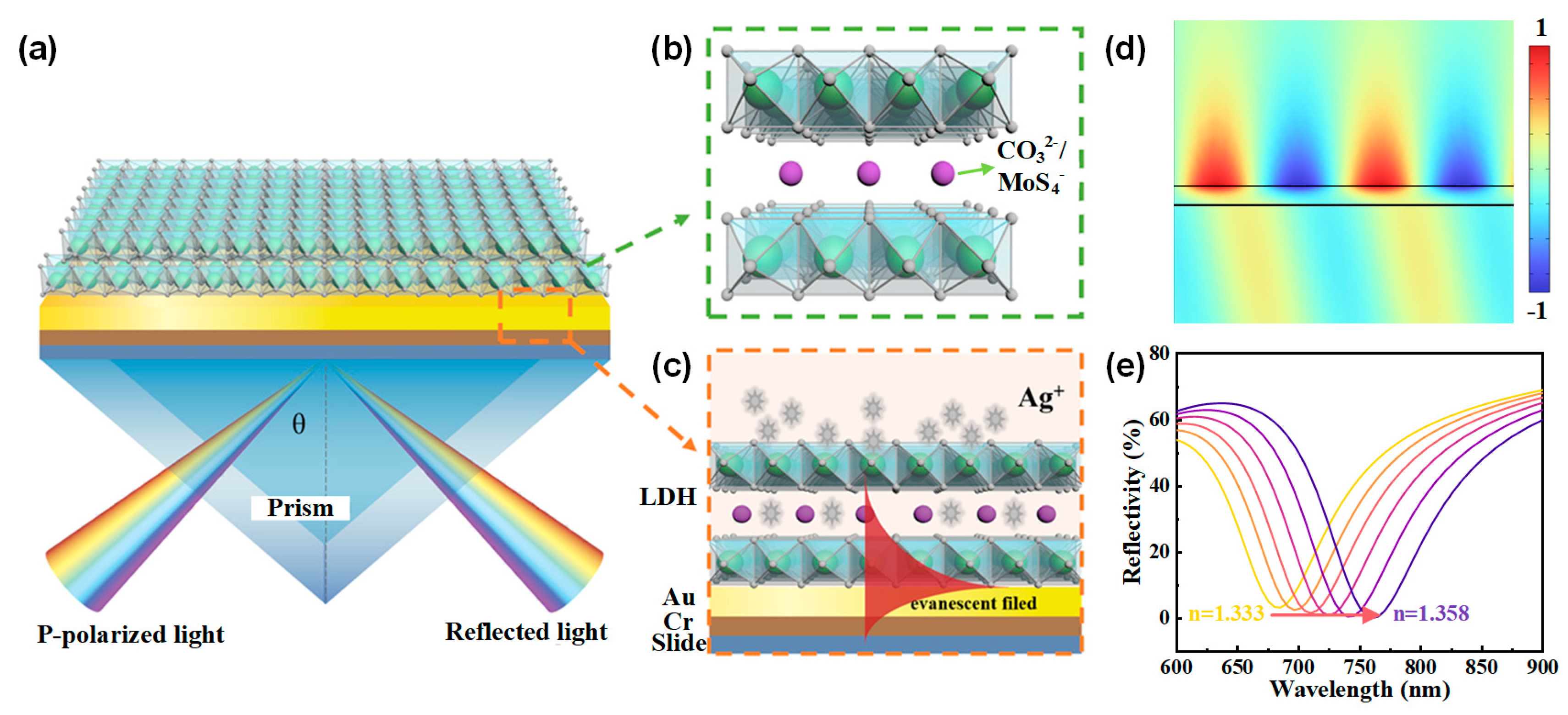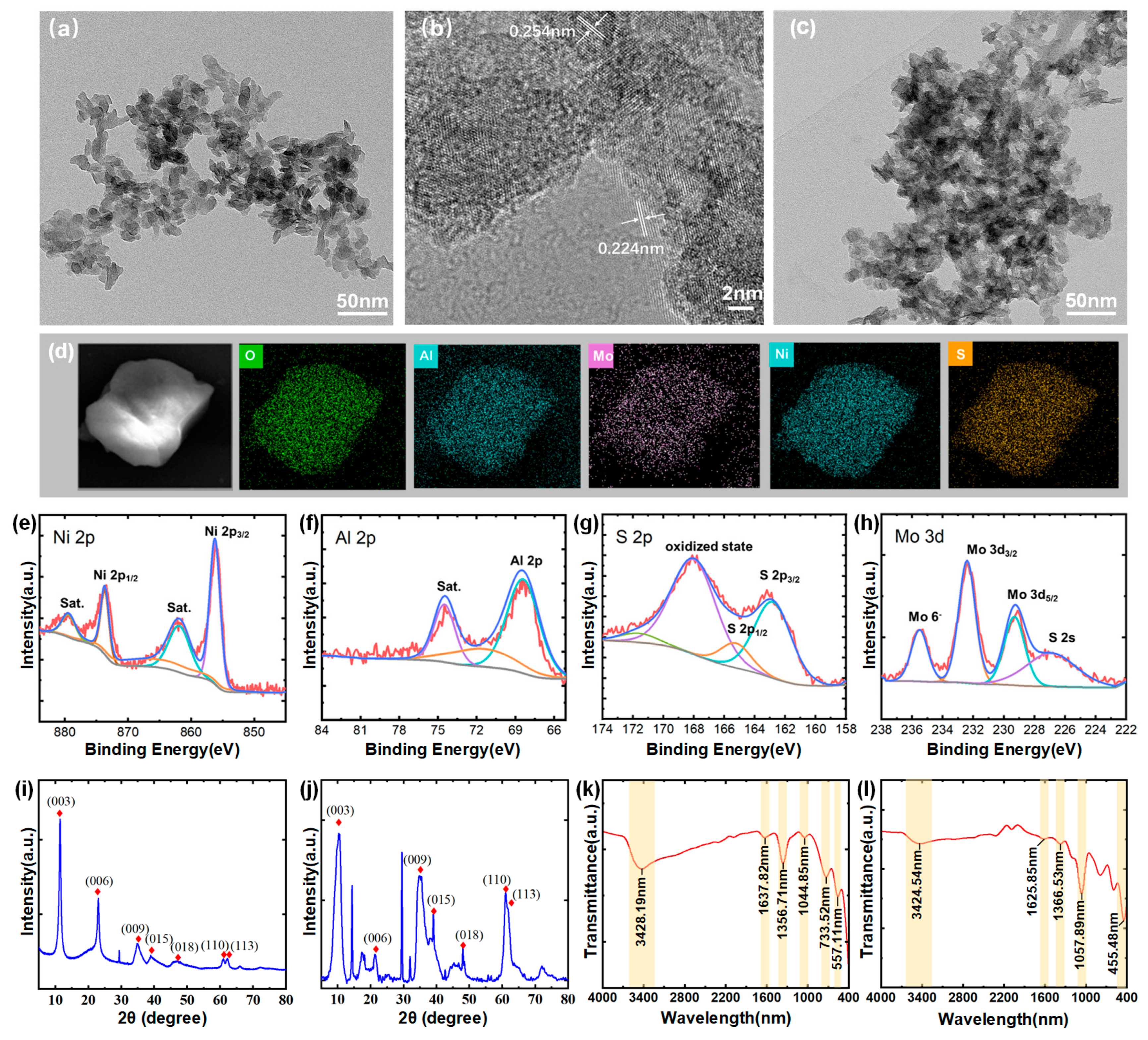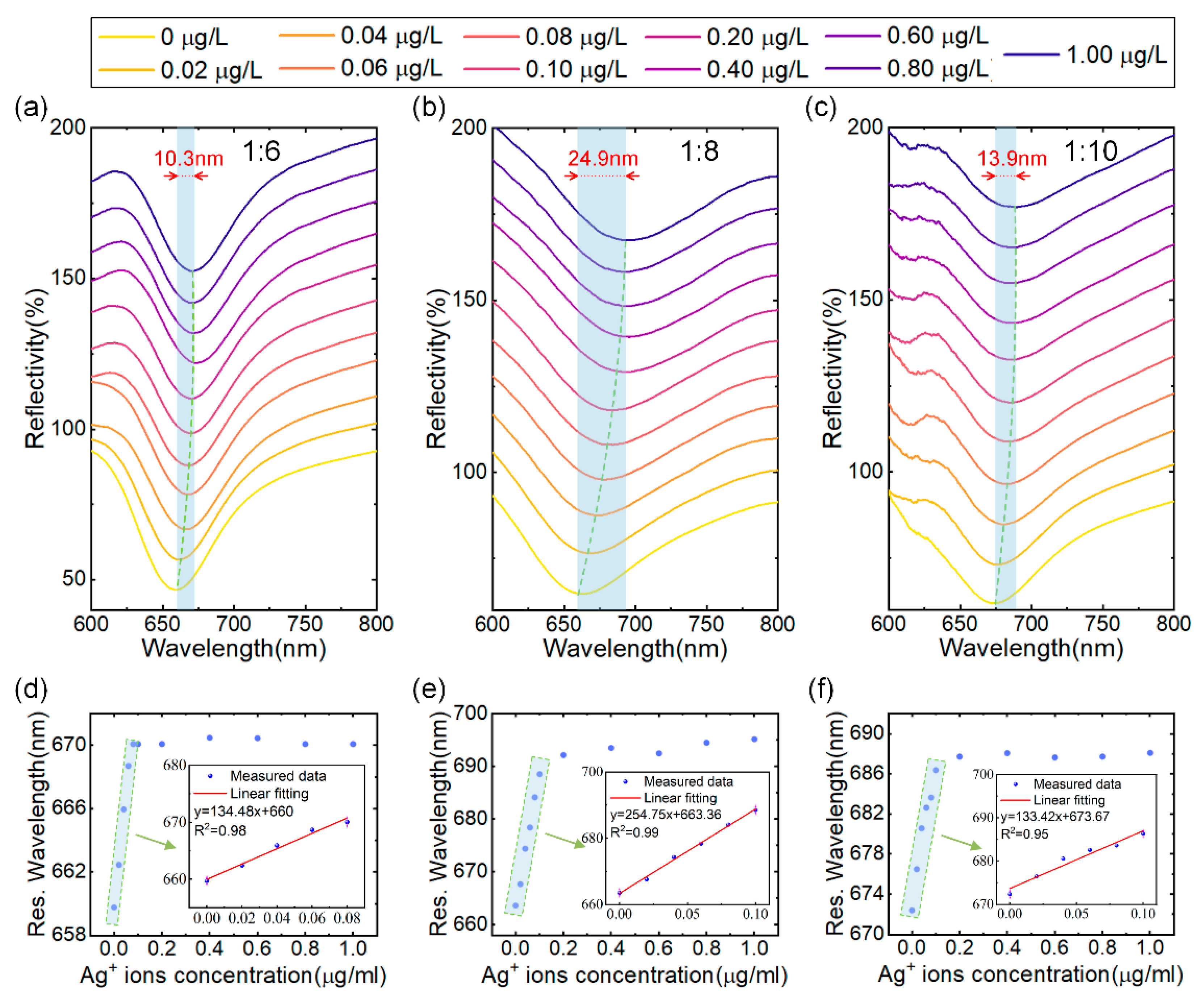Ultrasensitive Detection of Trace Silver Ions Using MoS42−-Intercalated LDH Nanosheets Enhanced SPR Sensor
Abstract
1. Introduction
2. Structure and Principle of the LDH-Based SPR Sensor
3. Material Preparation and Characterization
3.1. Reagents and Instruments
3.2. Characterization of the LDH Films
4. Performance of the MoS4-LDH-Based SPR Sensors
5. Conclusions
Author Contributions
Funding
Institutional Review Board Statement
Informed Consent Statement
Data Availability Statement
Conflicts of Interest
References
- Etesami, H. Bacterial Mediated Alleviation of Heavy Metal Stress and Decreased Accumulation of Metals in Plant Tissues: Mechanisms and Future Prospects. Ecotoxicol. Environ. Saf. 2018, 147, 175–191. [Google Scholar] [CrossRef] [PubMed]
- Yang, Q.; Li, Z.; Lu, X.; Duan, Q.; Huang, L.; Bi, J. A Review of Soil Heavy Metal Pollution from Industrial and Agricultural Regions in China: Pollution and Risk Assessment. Sci. Total Environ. 2018, 642, 690–700. [Google Scholar] [CrossRef] [PubMed]
- Karaouzas, I.; Kapetanaki, N.; Mentzafou, A.; Kanellopoulos, T.D.; Skoulikidis, N. Heavy Metal Contamination Status in Greek Surface Waters: A Review with Application and Evaluation of Pollution Indices. Chemosphere 2021, 263, 128192. [Google Scholar] [CrossRef] [PubMed]
- Ratte, H.T. Bioaccumulation and Toxicity of Silver Compounds: A Review. Environ. Toxicol. Chem. 1999, 18, 89–108. [Google Scholar] [CrossRef]
- Reidy, B.; Haase, A.; Luch, A.; Dawson, K.; Lynch, I. Mechanisms of Silver Nanoparticle Release, Transformation and Toxicity: A Critical Review of Current Knowledge and Recommendations for Future Studies and Applications. Materials 2013, 6, 2295–2350. [Google Scholar] [CrossRef] [PubMed]
- Bidmanova, S.; Kotlanova, M.; Rataj, T.; Damborsky, J.; Trtilek, M.; Prokop, Z. Fluorescence-Based Biosensor for Monitoring of Environmental Pollutants: From Concept to Field Application. Biosens. Bioelectron. 2016, 84, 97–105. [Google Scholar] [CrossRef]
- Liu, B.; Zhuang, J.; Wei, G. Recent Advances in the Design of Colorimetric Sensors for Environmental Monitoring. Environ. Sci. Nano 2020, 7, 2195–2213. [Google Scholar] [CrossRef]
- Ronkainen, N.J.; Halsall, H.B.; Heineman, W.R. Electrochemical Biosensors. Chem. Soc. Rev. 2010, 39, 1747. [Google Scholar] [CrossRef]
- Girigoswami, K.; Akhtar, N. Nanobiosensors and Fluorescence Based Biosensors: An Overview. Int. J. Nano Dimens. 2019, 10, 1–17. [Google Scholar]
- Wu, Y.; Feng, J.; Hu, G.; Zhang, E.; Yu, H.-H. Colorimetric Sensors for Chemical and Biological Sensing Applications. Sensors 2023, 23, 2749. [Google Scholar] [CrossRef]
- Hammond, J.L.; Formisano, N.; Estrela, P.; Carrara, S.; Tkac, J. Electrochemical Biosensors and Nanobiosensors. Essays Biochem. 2016, 60, 69–80. [Google Scholar] [PubMed]
- Willets, K.A.; Van Duyne, R.P. Localized Surface Plasmon Resonance Spectroscopy and Sensing. Annu. Rev. Phys. Chem. 2007, 58, 267–297. [Google Scholar] [CrossRef] [PubMed]
- Tao, N.J.; Boussaad, S.; Huang, W.L.; Arechabaleta, R.A.; D’Agnese, J. High Resolution Surface Plasmon Resonance Spectroscopy. Rev. Sci. Instrum. 1999, 70, 4656–4660. [Google Scholar] [CrossRef]
- Sagle, L.B.; Ruvuna, L.K.; Ruemmele, J.A.; Van Duyne, R.P. Advances in Localized Surface Plasmon Resonance Spectroscopy Biosensing. Nanomedicine 2011, 6, 1447–1462. [Google Scholar] [CrossRef]
- Gan, S.; Ruan, B.; Xiang, Y.; Dai, X. Highly Sensitive Surface Plasmon Resonance Sensor Modified with 2D Ti2C MXene for Solution Detection. IEEE Sens. J. 2021, 21, 347–352. [Google Scholar] [CrossRef]
- Forzani, E.S.; Foley, K.; Westerhoff, P.; Tao, N. Detection of Arsenic in Groundwater Using a Surface Plasmon Resonance Sensor. Sens. Actuators B Chem. 2007, 123, 82–88. [Google Scholar] [CrossRef]
- Daniyal, W.M.E.M.M.; Fen, Y.W.; Anas, N.A.A.; Omar, N.A.S.; Ramdzan, N.S.M.; Nakajima, H.; Mahdi, M.A. Enhancing the Sensitivity of a Surface Plasmon Resonance-Based Optical Sensor for Zinc Ion Detection by the Modification of a Gold Thin Film. RSC Adv. 2019, 9, 41729–41736. [Google Scholar] [CrossRef]
- Yang, M.; Xiong, X.; He, R.; Luo, Y.; Tang, J.; Dong, J.; Lu, H.; Yu, J.; Guan, H.; Zhang, J.; et al. Halloysite Nanotube-Modified Plasmonic Interface for Highly Sensitive Refractive Index Sensing. ACS Appl. Mater. Interfaces 2018, 10, 5933–5940. [Google Scholar] [CrossRef]
- Chen, Y.; Hu, S.; Wang, H.; Zhi, Y.; Luo, Y.; Xiong, X.; Dong, J.; Jiang, Z.; Zhu, W.; Qiu, W.; et al. MoS2 Nanosheets Modified Surface Plasmon Resonance Sensors for Sensitivity Enhancement. Adv. Opt. Mater. 2019, 7, 1900479. [Google Scholar] [CrossRef]
- Xue, T.; Qi, K.; Hu, C. Novel SPR Sensing Platform Based on Superstructure MoS2 Nanosheets for Ultrasensitive Detection of Mercury Ion. Sens. Actuators B Chem. 2019, 284, 589–594. [Google Scholar] [CrossRef]
- Luo, Y.; Hu, S.; Wang, H.; Chen, Y.; Dong, J.; Jiang, Z.; Xiong, X.; Zhu, W.; Qiu, W.; Lu, H.; et al. Sensitivity-Enhanced Surface Plasmon Sensor Modified with MoSe2 Overlayer. Opt. Express 2018, 26, 34250. [Google Scholar] [CrossRef] [PubMed]
- Wang, Y.; Wang, S.; Dong, N.; Kang, W.; Li, K.; Nie, Z. Titanium Carbide MXenes Mediated In Situ Reduction Allows Label-Free and Visualized Nanoplasmonic Sensing of Silver Ions. Anal. Chem. 2020, 92, 4623–4629. [Google Scholar] [CrossRef] [PubMed]
- Lin, C.; Song, X.; Ye, W.; Liu, T.; Rong, M.; Niu, L. Recent Progress in Optical Sensors Based on MXenes Quantum Dots and MXenes Nanosheets. J. Anal. Test. 2024, 8, 95–113. [Google Scholar] [CrossRef]
- Sadrolhosseini, A.R.; Naseri, M.; Kamari, H.M. Surface Plasmon Resonance Sensor for Detecting of Arsenic in Aqueous Solution Using Polypyrrole-Chitosan-Cobalt Ferrite Nanoparticles Composite Layer. Opt. Commun. 2017, 383, 132–137. [Google Scholar] [CrossRef]
- Fan, X.; Guo, Y.; Wang, L.; Qi, Y. Chitosan/Polyacrylic Acid Film Based on a Tapered Fiber Structure for the Ultrasensitive Detection of Cu2+ Concentration. Measurement 2024, 235, 114923. [Google Scholar] [CrossRef]
- Bai, J.; Zhang, X.; Wang, C.; Li, X.; Xu, Z.; Jing, C.; Zhang, T.; Jiang, Y. The Adsorption-Photocatalytic Synergism of LDHs-Based Nanocomposites on the Removal of Pollutants in Aqueous Environment: A Critical Review. J. Clean. Prod. 2024, 436, 140705. [Google Scholar] [CrossRef]
- Chaillot, D.; Bennici, S.; Brendlé, J. Layered Double Hydroxides and LDH-Derived Materials in Chosen Environmental Applications: A Review. Environ. Sci. Pollut. Res. 2021, 28, 24375–24405. [Google Scholar] [CrossRef]
- Yang, Z.; Wang, F.; Zhang, C.; Zeng, G.; Tan, X.; Yu, Z.; Zhong, Y.; Wang, H.; Cui, F. Utilization of LDH-Based Materials as Potential Adsorbents and Photocatalysts for the Decontamination of Dyes Wastewater: A Review. RSC Adv. 2016, 6, 79415–79436. [Google Scholar] [CrossRef]
- Wang, Z.; Zhang, L.; Fang, P.; Wang, L.; Wang, W. Study on Simultaneous Removal of Dye and Heavy Metal Ions by NiAl-Layered Double Hydroxide Films. ACS Omega 2020, 5, 21805–21814. [Google Scholar] [CrossRef]
- Wu, X.; Ci, C.; Du, Y.; Liu, X.; Li, X.; Xie, X. Facile Synthesis of NiAl-LDHs with Tunable Establishment of Acid-Base Activity Sites. Mater. Chem. Phys. 2018, 211, 72–78. [Google Scholar] [CrossRef]
- Liang, Z.; Huo, R.; Yin, Y.-X.; Zhang, F.; Xu, S.; Guo, Y.-G. Carbon-Supported Ni@NiO/Al2O3 Integrated Nanocomposite Derived from Layered Double Hydroxide Precursor as Cycling-Stable Anode Materials for Lithium-Ion Batteries. Electrochim. Acta 2013, 108, 429–434. [Google Scholar] [CrossRef]
- Shabanian, M.; Hajibeygi, M.; Raeisi, A. FTIR Characterization of Layered Double Hydroxides and Modified Layered Double Hydroxides. In Layered Double Hydroxide Polymer Nanocomposites; Elsevier: Amsterdam, The Netherlands, 2020; pp. 77–101. [Google Scholar]
- Foo, K.Y.; Hameed, B.H. Insights into the Modeling of Adsorption Isotherm Systems. Chem. Eng. J. 2010, 156, 2–10. [Google Scholar] [CrossRef]
- Pu, Z.-F.; Peng, J.; Wen, Q.-L.; Li, Y.; Ling, J.; Liu, P.; Cao, Q.-E. Photocatalytic Synthesis of BSA-Au Nanoclusters with Tunable Fluorescence for Highly Selective Detection of Silver Ion. Dye. Pigment. 2021, 193, 109533. [Google Scholar] [CrossRef]
- Wasiewska, L.A.; Seymour, I.; Patella, B.; Inguanta, R.; Burgess, C.M.; Duffy, G.; O’Riordan, A. Reagent Free Electrochemical-Based Detection of Silver Ions at Interdigitated Microelectrodes Using In-Situ PH Control. Sens. Actuators B Chem. 2021, 333, 129531. [Google Scholar] [CrossRef]
- Guo, J.; Ye, S.; Li, H.; Song, J.; Qu, J. Novel Carbon Dots with Dual Excitation for Imaging and Silver Ion Detection in Living Cells. Dye. Pigment. 2020, 183, 108723. [Google Scholar] [CrossRef]
- Zhao, L.; Wang, Y.; Li, Z.; Deng, Y.; Zhao, X.; Xia, Y. Facile Synthesis of Chitosan-Gold Nanocomposite and Its Application for Exclusively Sensitive Detection of Ag+ Ions. Carbohydr. Polym. 2019, 226, 115290. [Google Scholar] [CrossRef]
- Rathee, G.; Kohli, S.; Awasthi, A.; Singh, N.; Chandra, R. MoS42− Intercalated NiFeTi LDH as an Efficient and Selective Adsorbent for Elimination of Heavy Metals. RSC Adv. 2020, 10, 19371–19381. [Google Scholar] [CrossRef]
- Ma, L.; Wang, Q.; Islam, S.M.; Liu, Y.; Ma, S.; Kanatzidis, M.G. Highly Selective and Efficient Removal of Heavy Metals by Layered Double Hydroxide Intercalated with the MoS42– Ion. J. Am. Chem. Soc. 2016, 138, 2858–2866. [Google Scholar] [CrossRef]
- Ma, S.; Chen, Q.; Li, H.; Wang, P.; Islam, S.M.; Gu, Q.; Yang, X.; Kanatzidis, M.G. Highly Selective and Efficient Heavy Metal Capture with Polysulfide Intercalated Layered Double Hydroxides. J. Mater. Chem. A 2014, 2, 10280–10289. [Google Scholar] [CrossRef]







| Material | Method | Detection Limit | Reference |
|---|---|---|---|
| BSA-Au nanoclusters | Fluorescence | 0.226 μM | [34] |
| Gold interdigitated microband electrode | Electrochemistry | 13 nM | [35] |
| Carbon dots with dual excitation | Fluorescence probe | 15 nM | [36] |
| Chitosan-AuNPs | Colorimetry | 0.13 μM | [37] |
| MoS4-LDH | SPR | 2.8 pM | This work |
| Test Environment | Spiked Ag+ (μg/L) | Found Ag+ (μg/L) | Recovery (n = 3) | RSDs (n = 3) |
|---|---|---|---|---|
| Tap water | 0.02 | 0.0210 | 105% | 4.76% |
| 0.04 | 0.0395 | 98.75% | 2.28% | |
| River water | 0.02 | 0.0194 | 97% | 3.09% |
| 0.04 | 0.0406 | 101.5% | 1.94% |
Disclaimer/Publisher’s Note: The statements, opinions and data contained in all publications are solely those of the individual author(s) and contributor(s) and not of MDPI and/or the editor(s). MDPI and/or the editor(s) disclaim responsibility for any injury to people or property resulting from any ideas, methods, instructions or products referred to in the content. |
© 2024 by the authors. Licensee MDPI, Basel, Switzerland. This article is an open access article distributed under the terms and conditions of the Creative Commons Attribution (CC BY) license (https://creativecommons.org/licenses/by/4.0/).
Share and Cite
Tang, L.; Lan, G.; Ma, P.; Jia, Y.; Zhang, X.; Luo, P.; Wei, W. Ultrasensitive Detection of Trace Silver Ions Using MoS42−-Intercalated LDH Nanosheets Enhanced SPR Sensor. Sensors 2024, 24, 5973. https://doi.org/10.3390/s24185973
Tang L, Lan G, Ma P, Jia Y, Zhang X, Luo P, Wei W. Ultrasensitive Detection of Trace Silver Ions Using MoS42−-Intercalated LDH Nanosheets Enhanced SPR Sensor. Sensors. 2024; 24(18):5973. https://doi.org/10.3390/s24185973
Chicago/Turabian StyleTang, Linlong, Guilian Lan, Penglei Ma, Yu Jia, Xiaojian Zhang, Peng Luo, and Wei Wei. 2024. "Ultrasensitive Detection of Trace Silver Ions Using MoS42−-Intercalated LDH Nanosheets Enhanced SPR Sensor" Sensors 24, no. 18: 5973. https://doi.org/10.3390/s24185973
APA StyleTang, L., Lan, G., Ma, P., Jia, Y., Zhang, X., Luo, P., & Wei, W. (2024). Ultrasensitive Detection of Trace Silver Ions Using MoS42−-Intercalated LDH Nanosheets Enhanced SPR Sensor. Sensors, 24(18), 5973. https://doi.org/10.3390/s24185973






